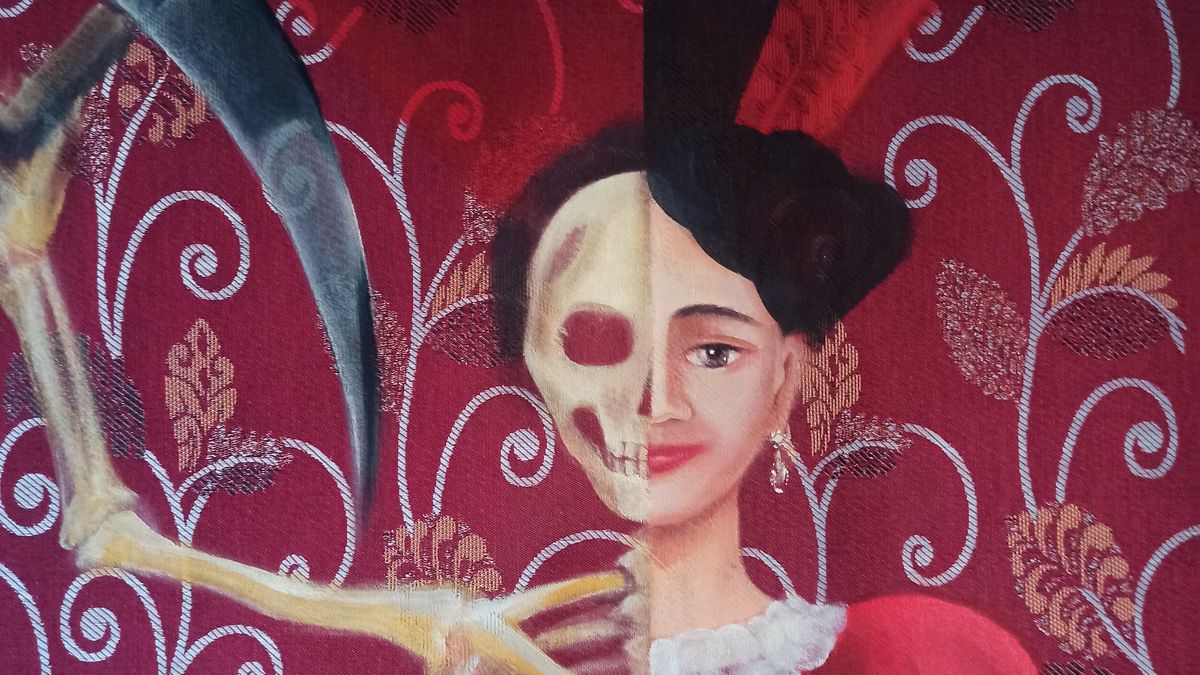The exhibition “Love the rose” by Xil Buffone (1966), was inaugurated a few days ago with the curatorship of Julio Sánchez Baroni, in the Vitriol jewelry and showroom. The ten banners that hang on the walls are dedicated to characters who span Argentine history in a period that goes from the year 1630, with the arrival of the Virgin of Luján, until 1848, when they shot Camila O’Gorman and the priest Uladislao Gutierrez.
The 1930s are marked with emphasis. In 1730 he was born in Santiago del Estero Santa Mama Antula, a lay woman who during the expulsion of the Jesuits founded the Holy House of Spiritual Exercises. Over there Buffone He found the place where he consolidates the intensity of his religious faith, as well as a model from antiquity to represent the image of life and death. Specifically, it is an oil painting Juan Visierartist who painted the life and death of a rosista lady in 1830.
The body appears cut in half, on the left side death (the skeleton) is displayed and, on the right, life (the body and its clothing). Buffone He recreates this configuration to paint his heroes, heroines and martyrs. Like the vanitas of the Baroque, the painting of Visier and also those of Buffone They aspire to remember that the splendor of life is inexorably temporary.
Mariano Moreno He is one of the characters in the show. And the painting of the banner reveals the dark circumstances of his death on the high seas, at the age of 32, and aboard an English frigate. Dark was against the privileges and ostentatious customs of Cornelio Saavedrapresident of the First Board, from his salary of 8 thousand pesos compared to the 3 thousand of the rest, among other benefits. “Equality above all”he claimed Dark. Then, the decree suppressing honors ratified his statements.
However, the greatest suspicion about the inconvenience caused by his criticism is seen in a strange arms purchase agreement, a document where a substitute for Dark faced with the possibility of his death. It is believed that he died of poisoning. His last words were dedicated to his “innocent wife,” painted on another banner, and then he exclaimed: “Long live the country, even if I perish”.
The following portraits present Guadalupe Cuenca de Moreno, José San Martín and Mariquita Sánchez de Thompson; Manuelita Rosas, Manuel Belgrano and Santa Mama Antula. In the category of martyrs are the young woman from Creole society Camila O’Gormanwho fell in love with the parish priest of Socorro, Uladislao Gutierrez. Defying the church and social prejudices, both escaped on December 12, 1847 and settled in Goya, Corrientes, dedicating themselves to teaching.
Meanwhile, criticism of sinners exacerbated the anger of Roses, who went out to look for them and alerted the population to report the lovers. The printed publication reported on filiation data: age, height, skin color, eyes, hair and some particular signs. The exhibition contains a facsimile version of the daguerreotype of Camila. During a dance at a judge’s house the lovers were discovered. Camila She was eight months pregnant, but her condition did not inspire pity. roses, He didn’t even listen to his daughter’s pleas. Manuelita. He immediately sent the order for them to be shot to the Santos Lugares camp where they were detained. They died together on August 18, 1848.
All characters hold a rose in one hand and a scythe in the other. The curator observes: “The rose, a flower with very rich symbolic connotations in the West -as is the lotus in the East-, as it alludes to ephemeral beauty and spiritual life. Buffone freely recreates the rose that appears in the engraving Summun Bonumm (1629) by the alchemist Robert Fludd with the inscription “Dat rosa mel apibus” (the rose provides honey to the bees)”
The artist expresses the objectives of her exhibition: “I start from a deep meditation on the emergence of the Argentine soul-people.” And in a text from “Ama la rosa”, he quotes Borges when he says: “Forgetting that he already was, I also wanted to be Argentine.” But beyond your way “being Argentine”, Borges observe that the rose expresses “the singular emotion called beauty, that beautiful mystery that neither psychology nor rhetoric deciphers”. And he then quotes Angelus Silesius. «The rose is without reason/ it blooms because it blooms/ it does not pay attention to itself, it does not/ it asks if they see it».
The exhibition talks about the attraction generated by a homeland where miracles thrive. This is how the story of the Virgin of Luján, patron saint of the Argentine people who arrived from San Pablo to the port of Buenos Aires. Her destination was a Buenos Aires ranch. “It was a rebellious terracotta figure, of the Pure and Clean Immaculate Conception. She packed herself into the cart with the oxen crossing the Luján River, she chose her territory and her devoted custodian: the black Manuel Costa de los Ríos, an African.points out Buffone.
In two years the production of the exhibition materialized. Today, taking into account that the banners with their bars and their fabrics were used in the past as a meeting point and means of communication during battles, in addition to being the support for images of devotion and religious brotherhood, it is likely that, for the closing of the sample, Xil Buffone organize a procession.
Source: Ambito
I am an author and journalist who has worked in the entertainment industry for over a decade. I currently work as a news editor at a major news website, and my focus is on covering the latest trends in entertainment. I also write occasional pieces for other outlets, and have authored two books about the entertainment industry.




